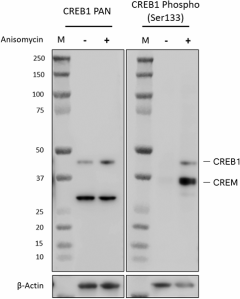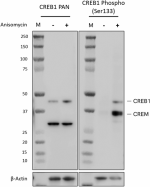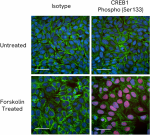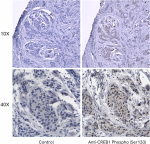- Clone
- A22026B (See other available formats)
- Regulatory Status
- RUO
- Other Names
- CAMP responsive element binding protein 1; CREB-1; Cyclic Adenosine 3',5'-Monophosphate Response Element-Binding Protein; CAMP-Responsive Element-Binding Protein 1
- Isotype
- Mouse IgG2b, κ
- Ave. Rating
- Submit a Review
- Product Citations
- publications

-

Whole cell extracts (15 µg protein) from serum-starved HeLa cells untreated (-) or treated (+) with Anisomycin were resolved on a 4-12% Bis-Tris gel, transferred to a PVDF membrane, and probed with Purified anti-CREB1 Phospho (Ser133) (clone A22026B) for 2 hours at room temperature. Proteins were visualized by chemiluminescence detection using HRP Goat anti-mouse IgG (Cat. No. 405306) at a 1:3000 dilution. Direct-Blot™ HRP anti-β-actin (Cat. No. 643807) was used as a loading control at a 1:10000 dilution. Equal CREB1 loading was confirmed by probing membranes with anti-Pan CREB1 (left blot). Western-Ready™ ECL Substrate Premium Kit (Cat. No. 426319) was used as a detection agent. Lane M: Molecular weight marker -

A-431 cells untreated (top panels) or treated with Forskolin (bottom panels) were fixed and permeabilized with 2% PFA and ice-cold methanol, and then intracellularly stained with Purified anti-CREB1 Phospho (Ser133) (clone A22026B) (right panels) or Purified mouse IgG2b, κ isotype control (Cat. No. 400302) (left panels) followed by Alexa Fluor® 647 anti-mouse IgG (Cat No. 405322). Cells were counterstained with DAPI (Cat. No. 422801) (blue) and Alexa Fluor® 488 anti-Cytokeratin (clone C-11) (Cat. No. 628608) (green). Images were captured using a Revvity Operetta CLS™ High Content Analysis System with a 60X objective. Scale bar: 50 µm. -

Serum starved Jurkat cells untreated (negative control, open histogram), or treated with Forskolin (positive control, filled histogram) were fixed and permeabilized using the True-Phos™ Perm Buffer Set (Cat. No. 425401) and intracellularly stained with Purified anti-CREB1 Phospho (Ser133) (clone A22026B) or Purified Mouse IgG2b, κ Isotype Control (open histogram, dashed line) (representative histogram or either untreated or treated cells) (Cat. No. 400302) followed by Alexa Fluor® 647 Goat anti-mouse IgG (Cat. No. 405322). -

IHC staining of CREB1 Phospho (Ser133) on formalin-fixed paraffin-embedded human breast cancer tissue was performed following antigen retrieval using Sodium Citrate H.I.E.R. (Cat. No. 928502). Tissue sections were incubated without (control, left panels) or with Purified anti-CREB1 Phospho (Ser133) (Clone A22026B) (right panels) overnight at 4°C. BioLegend’s Ultra Streptavidin HRP Kit (Multi-Species, DAB, Cat. No. 929501) was used for detection followed by hematoxylin counterstaining, according to the protocol provided. Images were captured with a 10X (top panels) and 40X (bottom panels) objectives. -

IHC staining of CREB1 Phospho (Ser133) on formalin-fixed paraffin-embedded human breast cancer tissue was performed following antigen retrieval using Tris-EDTA (10 mM Tris, 1 mM EDTA, 0.05% Tween-20, pH 9.0). The tissue sections were incubated with (right panels) or without (left panels) Lambda Phosphatase (LPP). All sections were incubated with Purified anti-CREB1 Phospho (Ser133) (clone A22026B) overnight at 4°C followed by incubation with Alexa Fluor® 647 Goat anti-mouse IgG (Cat. No. 405322) for 1 hour at room temperature. Nuclei were counterstained with DAPI (Cat. No. 422801).
| Cat # | Size | Price | Quantity Check Availability | Save | ||
|---|---|---|---|---|---|---|
| 632551 | 25 µg | 170 CHF | ||||
| 632552 | 100 µg | 445 CHF | ||||
Cyclic AMP (cAMP)-response element-binding protein 1 (CREB1) is a phosphorylation-dependent transcription factor that binds to the cAMP response element (CRE) in response to certain stimuli. CREB1 contains a basic leucine zipper (bZIP) DNA-binding domain, 1 dimerization domain, and 9 serine residues in 1 kinase inducible domain phosphorylated by multiple kinases, including Ca2+/CaM-dependent kinase (CaMK) II and IV, protein kinase A (PKA), protein kinase C (PKC), mitogen/stress-activated kinase (MSK), ribosomal S6 kinase (RSK), AKT, and MAPKAP kinase 2 (MK2). Both the protein levels and activation of CREB1 are vital for maintaining cellular homeostasis in physiological and pathological conditions. Phosphorylation of CREB1 at Ser133 promotes the recruitment of co-activator proteins CBP and p300, which has been proposed to increase transcription of CREB-dependent genes. Ser133 can also be phosphorylated by other proteins such as MSK1/2 in response to the activation of MAPK signaling.
Product DetailsProduct Details
- Verified Reactivity
- Human
- Antibody Type
- Monoclonal
- Host Species
- Mouse
- Immunogen
- Synthetic peptide for human CREB1 phosphorylated at serine 133
- Formulation
- Phosphate-buffered solution, pH 7.2, containing 0.09% sodium azide
- Preparation
- The antibody was purified by affinity chromatography.
- Concentration
- 0.5 mg/mL
- Storage & Handling
- The antibody solution should be stored undiluted between 2°C and 8°C.
- Application
-
WB - Quality tested
ICC, ICFC, IHC-P - Verified - Recommended Usage
-
Each lot of this antibody is quality control tested by western blotting. For western blotting, the suggested use of this reagent is 0.25 - 1 µg/mL. For immunocytochemistry, a concentration range of 1.25 - 10 μg/mL is recommended. For intracellular flow cytometric staining, the suggested use of this reagent is ≤ 0.125 µg per million cells in 100 µL volume. For immunohistochemistry on formalin-fixed paraffin-embedded tissue sections, a concentration range of 1 - 10 µg/mL is suggested. It is recommended that the reagent be titrated for optimal performance for each application.
- Application Notes
-
For immunocytochemistry (ICC), we recommend to fix and perm the cells with either PFA-triton X-100, or PFA-Methanol. Fixation/permeabilization with methanol-only is not a suitable method for this antibody.
- RRID
-
AB_3097586 (BioLegend Cat. No. 632551)
AB_3097586 (BioLegend Cat. No. 632552)
Antigen Details
- Structure
- CREB1 contains 327 amino acids at a predicted molecular weight around 37 kD.
- Distribution
-
Ubiquitously expressed/Nucleus
- Function
- Under physiological conditions, CREB1 maintains cellular survival, proliferation, anti-inflammatory immune responses and modulates the development of the nervous system by serving a neuroprotective role. Under pathological conditions, increased levels of CREB1 is associated with acute lymphoblastic leukemia (ALL), acute myeloid leukemia (AML), Hodgkin’s lymphoma, chronic lymphatic leukemia (CLL), melanoma, hepatocellular, renal cell, ovarian, prostate, lung, gastric, esophageal, pancreatic, and breast tumors. CREB1 is also involved in the aging process by regulating the downstream signals of mitochondria dysfunction.
- Interaction
- CREB1 interacts with CREBBP, CRTC2, EP300, CRTC1, JUN, AKT1, CAMK4, FOS, RPS6KA1, RPS6KA3, CaMKII, CaMKIV, PKA, PKC, MSK, RSK, AKT, and MK2.
- Cell Type
- B cells, Endothelial cells, Fibroblasts, Granulocytes, Macrophages, NK cells, T cells
- Biology Area
- Cell Biology, Transcription Factors
- Antigen References
-
- Steven A, et al. 2020. Cell Mol Life Sci. 77:4049-4067.
- Lin PH, et al. 2020. Diagnostics (Basel). 10:295.
- Sakamoto K, et al. 2011. J Neurochem. 116:1-9.
- Wen AY, et al. 2010. J Immunol. 185:6413-9.
- Arnould T, et al. 2002. EMBO J. 21:53-63.
- Naqvi S, et al. 2014. Biochem J. 458:469-79.
- Gene ID
- 1385 View all products for this Gene ID
- UniProt
- View information about CREB1 on UniProt.org
Related FAQs
Other Formats
View All CREB1 Reagents Request Custom Conjugation| Description | Clone | Applications |
|---|---|---|
| Purified anti-CREB1 Phospho (Ser133) | A22026B | WB,ICC,ICFC,IHC-P |
| Alexa Fluor® 647 anti-CREB1 Phospho (Ser133) | A22026B | ICFC |
| PE anti-CREB1 Phospho (Ser133) | A22026B | ICFC |
Compare Data Across All Formats
This data display is provided for general comparisons between formats.
Your actual data may vary due to variations in samples, target cells, instruments and their settings, staining conditions, and other factors.
If you need assistance with selecting the best format contact our expert technical support team.
-
Purified anti-CREB1 Phospho (Ser133)

Whole cell extracts (15 µg protein) from serum-starved HeLa ... 
A-431 cells untreated (top panels) or treated with Forskolin... 
Serum starved Jurkat cells untreated (negative control, open... 
IHC staining of CREB1 Phospho (Ser133) on formalin-fixed par... 
IHC staining of CREB1 Phospho (Ser133) on formalin-fixed par... -
Alexa Fluor® 647 anti-CREB1 Phospho (Ser133)

Serum starved Jurkat cells untreated (negative control, open... -
PE anti-CREB1 Phospho (Ser133)

Serum starved Jurkat cells untreated (low-expressing cell li...
 Login / Register
Login / Register 







Follow Us